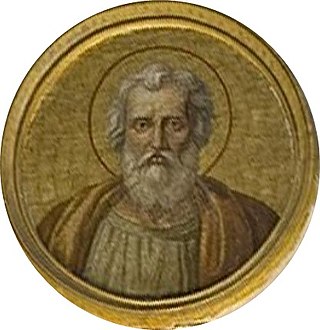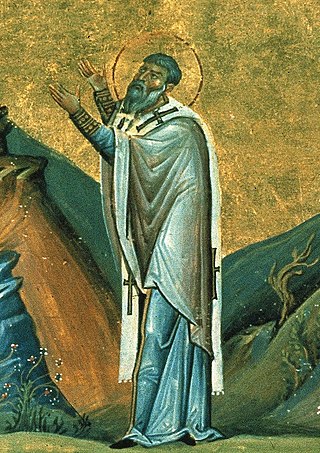
Antipope Felix was a Roman archdeacon in the 4th century who was installed irregularly in 355 as an antipope and reigned until 365 after Emperor Constantius II banished the then current pope, Liberius. Constantius, following the refusal of the laity to accept Felix, attempted to have them co-rule, but Felix was forced to retire. He was resented in his lifetime but has enjoyed a more popular memory since.

Pope Agapetus I was the bishop of Rome from 13 May 535 to his death. His father, Gordianus, was a priest in Rome and he may have been related to two popes, Felix III and Gregory I.

Pope Sixtus II, also written as Pope Xystus II, was bishop of Rome from 31 August 257 until his death on 6 August 258. He was martyred along with seven deacons, including Lawrence of Rome, during the persecution of Christians by the Emperor Valerian.

Hadrumetum, also known by many variant spellings and names, was a Phoenician colony that pre-dated Carthage. It subsequently became one of the most important cities in Roman Africa before Vandal and Umayyad conquerors left it ruined. In the early modern period, it was the village of Hammeim, now part of Sousse, Tunisia.

Ammon, Amun, Ammonas, Amoun (Ἀμοῦν), or Ammonius the Hermit was a 4th-century Christian ascetic and the founder of one of the most celebrated monastic communities in Egypt. He was subsequently declared a saint. He was one of the most venerated ascetics of the Nitrian Desert, and Athanasius of Alexandria mentions him in his life of Anthony the Great.
Acacius of Beroea, a Syrian, lived in a monastery near Antioch, and, for his active defense of the Church against Arianism, was made Bishop of Berroea in 378 AD, by Eusebius of Samosata.

Saint Anastasia is a Christian saint and martyr who died at Sirmium in the Roman province of Pannonia Secunda. In the Eastern Orthodox Church, she is venerated as St. Anastasia the Pharmakolytria, i.e. "Deliverer from Potions". This epithet is also translated as "One who Cures (Wounds)" in Lampe's A Patristic Greek Lexicon.

Satibarzanes, a Persian, was satrap of Aria under Darius III, king of Persia.
Alban of Mainz was a Catholic priest, missionary, and martyr in the Late Roman Empire. He is venerated as Saint Alban of Mainz in the Catholic Church, not to be confused with Saint Alban of Verulamium.

Alexander of Jerusalem was a third century bishop who is venerated as a martyr and saint by the Eastern Orthodox Church, Oriental Orthodox churches, and the Roman Catholic Church. He died during the persecution of Emperor Decius.
Epipodius and his companion Alexander are venerated as Christian saints. Their feast day is 22 April, and Alexander is additionally commemorated on April 24 in the Eastern Orthodox Church. Epipodius was a native of Lyon; Alexander was said to be a native of Phrygia, and a physician by profession. They were both martyred during the reign of Marcus Aurelius.

Abercius of Hieropolis was a bishop of Hierapolis at the time of Roman emperor Marcus Aurelius, also known as Abercius Marcellus. It is generally considered that he was the successor to Papias.
Hasdrubal the Boetharch was a Carthaginian general during the Third Punic War. Little is known about him. "Boetharch" was a Carthaginian office, the exact function of which is unclear. It may derive from the Ancient Greek term "βοηθός (boēthós)" or "auxiliary," suggesting a leadership role among Carthage's mercenary armies. It is not to be confused with the Greek title boeotarch—a leader of the Boeotian Confederacy.
Astius is a 2nd-century Christian martyr venerated by the Roman Catholic and Eastern Orthodox churches. He was the bishop of Dyrrhachium. According to legend, he was arrested by Agricola, the Roman governor of Dyrrachium, and was tortured to death around 98 AD for refusing to worship the god Dionysius. He was crucified during the persecution of Christians under the Roman emperor Trajan.
Theonistus is a saint venerated by the Catholic Church. Theonistus is venerated with two companions, Tabra and Tabratha. Medieval documents give accounts of his life, which are contradictory and confused.
Quintian (Quinctianus), Lucius and Julian (Julianus) are venerated as saints and martyrs by the Roman Catholic Church. According to the Roman Martyrology, they were inhabitants of North Africa who were killed during the persecutions of the Vandal king Huneric, who was an Arian. However, the date of their martyrdom may be conjectural. They are the only ones named in a group of sixteen martyrs, which included several women.

December 5 - Eastern Orthodox liturgical calendar - December 7
Honoratus Antoninus was a bishop of Constantine (Cirta) in the Roman province of Africa. He was alive during the persecution of the Catholics by the Vandal king Gaiseric in the 5th century, around the year 437.
Vigilius of Thapsus also known as Vigilius Tapsensis, Vigilius Afer, or Vergil of Tapso, was a 5th-century Bishop of Thapsus in the province Byzacium, in what is now Tunisia, and as well as a theological writer and polemicist.
Arcadius, Paschasius, Probus and Eutychius were Chalcedonian Christian martyrs. Natives of Hispania, they became loyal counsellors of the Vandal king Gaiseric, but were ultimately proscribed, exiled, tortured and executed in 437 for refusing the king's command to convert to Arianism. Their story is recounted in the contemporary chronicle of Prosper of Aquitaine. Paschasius and Eutychius, whose name is sometimes given as Eutychian, were brothers.
|Feast_day:St Aemilianus, martyr of Mesia is on July 18, according to the Roman martyrology.










